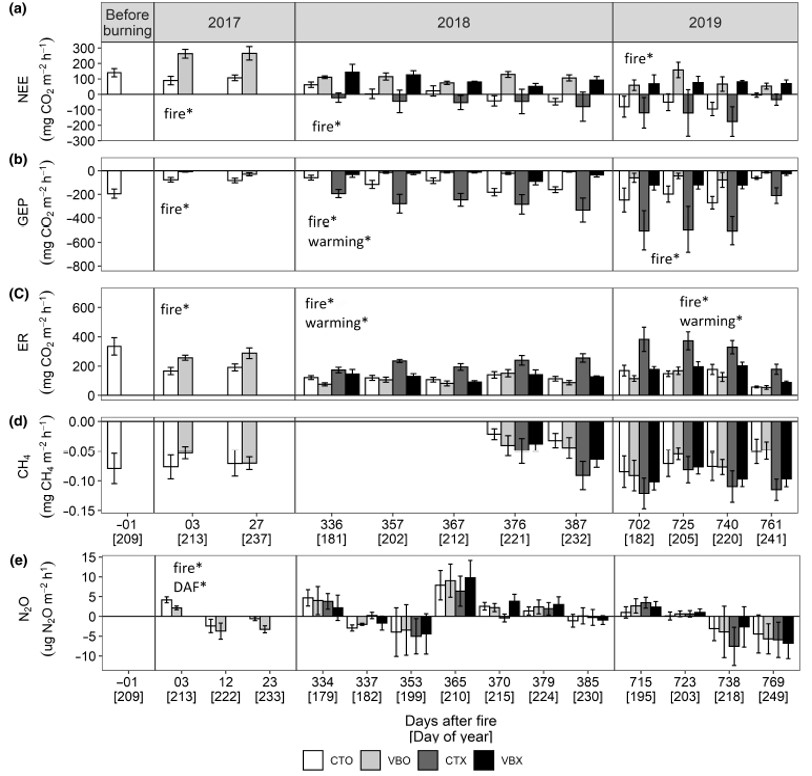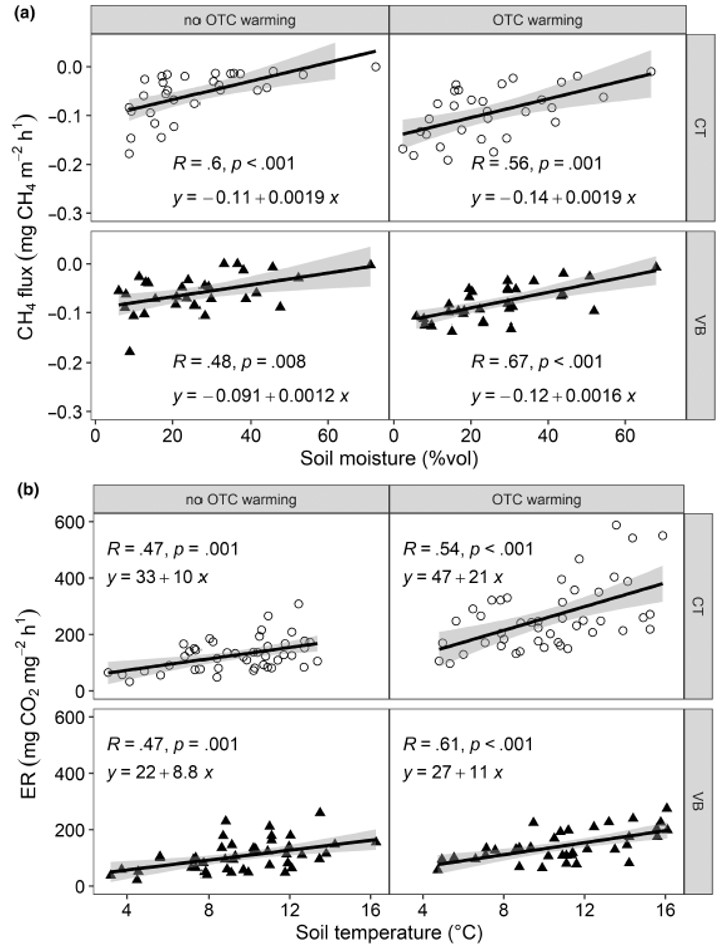In the Arctic, the air temperature has increased more than twice the global average during the last few decades and may increase by 2-8°C before 2100. Wildfire frequency and expanse in the Arctic have increased in recent years. It can markedly disturb tundra ecosystems in different ways, including above-and belowground plant biomass destruction and alter soil properties through changes in the availability of soil phosphorus (P), nitrogen (N), and carbon (C). At high latitudes, the frequency and extension of tundra fires are related to climatic conditions, and the increased occurrence of fire events that have been linked to changes toward drier and warmer summers. Approximately half of the global soil C is deposited in the Arctic. Thus, climate change and increased fires in these regions can lead to high amounts of C released into the atmosphere, affecting the global C budget, and leading to positive climate feedback. And some studies found that fires can lead to increased CH4 uptake rates in well-drained soils, which was linked to decreased soil moisture and increased soil temperature. However, there seem to be a lack of quantification of immediate and short-term net exchange rates of CO2, CH4, and N2O following an experimental fire in the Arctic.
Based on this, in this article, a group of scientists from University of Copenhagen reported immediate (after 1-27 days) and short-term (after 1 and 2 years) in situ measurements of CH4, CO2 (Picarro GasScouterTM G4301 Mobile Gas Concentration Analyzer), and N2O fluxes in a well-drained tundra ecosystem in West Greenland following experimental fire. The authors collected the air temperature and precipitation data and measured soil temperatures during the burning process in 2 and 5 cm depths. Soil cores of the top 0-5 cm soil (2 cm diameter) were sampled volumetric in August 2017, July 2018, and July 2019 for analysis of total and soluble C, N, and P. Additionally, samples from 2017 were analyzed for pH and C:N ratio. Water-soluble was extracted from moist soil and filtered for NO3--N, NH4+-N and PO43--P measurement. The aims were to (1) quantify immediate and short-term net CO2, CH4, and N2O exchange rates following an experimental fire, (2) identify factors that limit processes responsible for net ecosystem GHG exchange (3) test the relationship between temporal changes in soil physicochemical conditions and net GHG exchange, and (4) quantify effects of fire on net GHG exchange rates under climate warming.
[Results]:

Manual measurements of gas fluxes in treatment plots averaged by campaign across the sampling seasons (a) NEE, (b) GEP, (d) ER, (d) CH4, and (e) N2O.

Relationship between in situ soil CH4 uptake rates and soil moisture content (a) and in situ ER rates and soil temperature (b).
[Conclusion]:
The authors concluded that this study addresses the knowledge gap of immediate and short-term effects of experimental fire on GHG exchange in an Arctic upland tundra ecosystem. The combustion of aboveground vegetation by the fire turned burnt areas into net CO2 sources throughout the entire study period. In burnt areas, the effect of an increase in net CO2 release was mainly linked to decreased photosynthetic activity and an immediate increase in ER. Even when combined with warming, neither photosynthetic activity nor ecosystem respiration increased in burnt plots, despite the significant temperature increase of 1°C by OTCs. Although the experimental and relatively low-severity fire was a destructive force on the aboveground, it only had a limited impact immediately after the fire on the belowground properties and variations in processes over seasons and between years, which were rather driven by weather conditions. Thus, in a well-drained Arctic tundra ecosystem, the short-term effects of a low-intensity fire event on belowground associated GHG processes, such as CH4 and N2O consumption and production are likely to be negligible. Overall, variances of net soil uptake of CH4 in ambient as well as warmer conditions were primarily controlled by soil moisture levels. Destruction of vegetation by the fire and the subsequent inorganic N flush did not have the hypothesized stimulatory effect on the generally low N2O emissions, but immediately after the fire N2O fluxes significantly decreased. However, already 1 and 2 years there was no fire effect on N2O fluxes neither with nor without warming. The total GHG budget, in CO2-eq fluxes in this well-drained Arctic tundra ecosystem emphasizes the predominant contribution of CO2 efflux following the fire. An important factor in the longer-term effects of a typical fire is therefore the rate of plant recovery and their uptake of CO2. In this study, the authors addressed the effects of a typical fire in a well-drained tundra with a shallow organic layer. Many wildfires cause both low and highly severely burnt areas, particularly in ecosystems with deeper peat formation, which may lead to greater effects on the net GHG budget. Thus, further research on the effect of high-severity and high-intensity fires on fluxes of all three GHG in an upland Arctic tundra as well as in other Arctic ecosystems is needed.